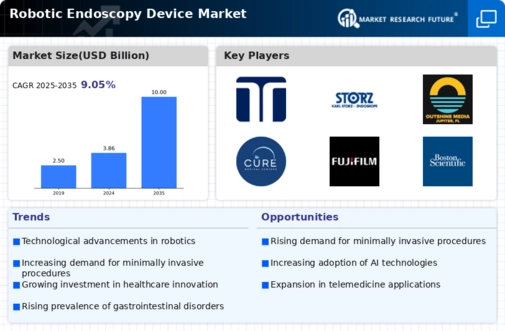Market Growth Projections
The Global Robotic Endoscopy Device Market Industry is projected to experience substantial growth over the next decade. With an estimated market value of 3.86 USD Billion in 2024, the industry is on a trajectory to reach 10 USD Billion by 2035. This growth is driven by various factors, including technological advancements, increasing healthcare expenditure, and a rising demand for minimally invasive procedures. The anticipated CAGR of 9.04% from 2025 to 2035 indicates a robust expansion phase for the market. These projections highlight the evolving landscape of surgical practices and the critical role that robotic endoscopy devices will play in shaping the future of healthcare.
Technological Advancements
The Global Robotic Endoscopy Device Market Industry is experiencing rapid technological advancements that enhance the precision and efficacy of surgical procedures. Innovations such as 3D imaging, enhanced visualization, and improved robotic manipulation systems are becoming increasingly prevalent. These advancements not only improve patient outcomes but also reduce recovery times, which is a critical factor in surgical settings. As a result, the market is projected to reach 3.86 USD Billion in 2024, reflecting a growing demand for sophisticated robotic systems in healthcare. The integration of artificial intelligence and machine learning further augments the capabilities of robotic endoscopy devices, indicating a promising future for the industry.
Increasing Healthcare Expenditure
The Global Robotic Endoscopy Device Market Industry is benefiting from increasing healthcare expenditure across various regions. Governments and private sectors are investing heavily in advanced medical technologies to improve healthcare infrastructure and patient care. This trend is particularly evident in developed nations, where healthcare budgets are expanding to accommodate new technologies. As a result, the market is anticipated to grow at a CAGR of 9.04% from 2025 to 2035, reflecting the commitment to integrating robotic systems into surgical practices. Enhanced funding for research and development in robotic endoscopy devices is likely to yield innovative solutions that further drive market growth.
Rising Incidence of Chronic Diseases
The Global Robotic Endoscopy Device Market Industry is significantly driven by the rising incidence of chronic diseases such as cancer and gastrointestinal disorders. As these conditions become more prevalent, the demand for minimally invasive surgical procedures increases, leading to a greater reliance on robotic endoscopy devices. For instance, the World Health Organization indicates that cancer cases are expected to rise, necessitating advanced surgical interventions. This trend is expected to propel the market to an estimated 10 USD Billion by 2035, as healthcare providers seek innovative solutions to improve patient care and surgical outcomes. The ability of robotic systems to perform complex procedures with precision is likely to be a key factor in this growth.
Enhanced Training and Education Programs
The Global Robotic Endoscopy Device Market Industry is also influenced by enhanced training and education programs for healthcare professionals. As the complexity of robotic systems increases, the need for specialized training becomes paramount. Institutions are developing comprehensive training modules that equip surgeons with the necessary skills to operate robotic endoscopy devices effectively. This focus on education not only improves surgical outcomes but also fosters greater acceptance of robotic technologies in clinical settings. As more healthcare providers become proficient in using these devices, the market is likely to see accelerated growth, contributing to the projected CAGR of 9.04% from 2025 to 2035.
Growing Demand for Minimally Invasive Procedures
The Global Robotic Endoscopy Device Market Industry is witnessing a growing demand for minimally invasive procedures, which are associated with reduced patient trauma and shorter recovery times. Patients and healthcare providers increasingly prefer these techniques due to their benefits, including less postoperative pain and lower complication rates. As surgical practices evolve, robotic endoscopy devices are becoming essential tools for performing complex procedures with minimal invasiveness. This shift in preference is expected to contribute to the market's expansion, with projections indicating a rise to 10 USD Billion by 2035. The ability of robotic systems to enhance precision and control during surgeries aligns well with the increasing demand for such procedures.




















Leave a Comment